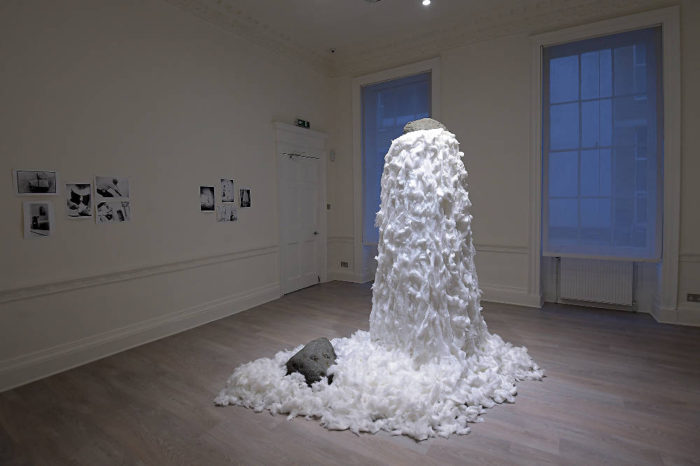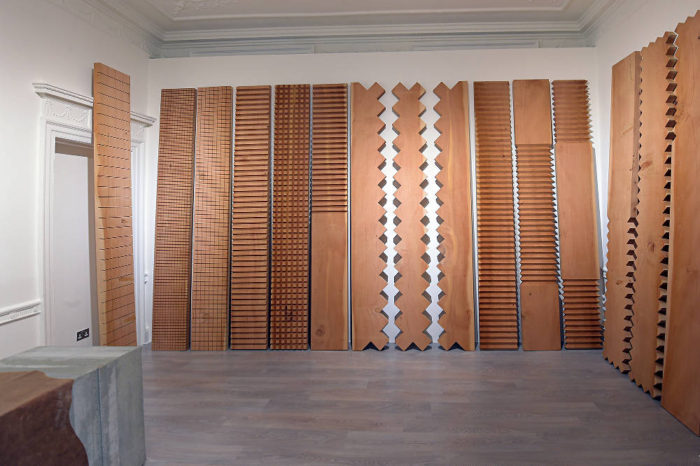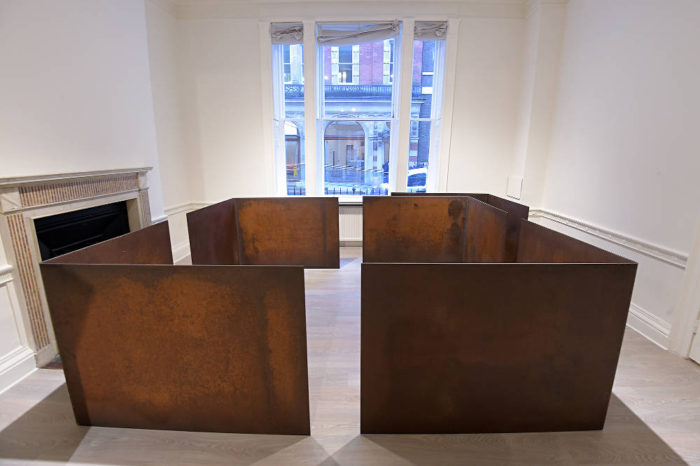Cardi Gallery London presents ‘Tribute to Mono-Ha’, an anthology exhibition dedicated to the pioneering Japanese movement Mono-ha, introducing the London public to seminal works by artists Koji Enokura, Noriyuki Haraguchi, Susumu Koshimizu, Lee Ufan, Katsuhiko Narita, Nobuo Sekine, Kishio Suga, Jiro Takamatsu, Noboru Takayama and Katsuro Yoshida.

Mono-ha (“The School of Things”) emerged in 1968 Tokyo as one of a number of networks engaged in radical counter-art practices of non-making that characterized the post-war Japanese artistic discourse, such as the Gutai group in the ‘50s, the Neo-Dada Organisers and Hi-Red Center in the early ‘60s. The young artists of Mono-ha never formalized into a group devoted to a fixed doctrine or manifesto: they were a polyphony of artistic voices maintaining their own distinctly personal ways of working while sharing similar concerns. Although some of them were directly engaged in critical conversations, writing or even working together (Yoshida and Koshimizu were instrumental to the design and execution of the seminal piece of Mono-ha: Sekine’s Phase-Mother Earth, a 2.6-meter-high and 2.2-meter-wide cylinder of dirt next to an identically shaped hole in the ground shown at 1968’s Contemporary Sculpture Exhibition in Kobe), or often showed alongside one another at Tokyo galleries between the end of the ‘60s and the early ‘70s, these artists never organized Mono-ha exhibitions their works were often displayed alongside those of non-Mono-ha artists in museum shows.
Until World War II Japanese Modernism had presented a local version of all major Western art movements the introduction of new trends and styles permeating from the West having been injected with native sensibility since the Meji period (1868-1912). The aftermath of the conflict saw the development of a new web of international relations and alongside it, a larger influx of Western art especially from France and the United States. The reconstruction process was rapid: from a defeated country rising from the ashes of its nuclear trauma, Japan quickly transformed into an industrial, strongly urbanized nation. The individual’s awareness of the self completely dismantled, this new expanding Japan required a reconstruction able to entirely redesign and reaffirm ideologies, philosophies and principles that the individual stands for, in a novel way aligned with the changing times.
The second half of the ‘60s, was a site of animated discussions in the political and cultural arenas: from the student movements’ yearning for radical reform, to the desire of redefining the country’s identity and position on the world’s map. Mono-ha artists – many still studying at Tokyo’s Tama Art University at the time – embarked in a quest for the essential. Turning to Taoist philosophy, they embraced the notion that perception should be freed of names and concepts, to allow things to be seen as they are when removed from their ordinary context. In an effort to revitalize art, they saw a projection of selfhood in Modernist self-referential art and in those prepared artist’s materials art had relied upon, which they rejected.
By starting at the level of thing (Mono) and matter, these artists found stimulation in the power of reality inherent in the very existence of things. Having stripped away the concepts related to specific things and materials, they revealed a new world of meaning through their explorations of the essential, creating a new formal vocabulary where the artwork is involuntarily, metaphysically transformed into one single signifier through a process of abstraction coinciding with the physical presence of things. Rejecting the traditional artist’s materials, they turned to simple, widely available natural and industrial ones which were embedded in their contemporaneity (cloth, rocks, wood, paper, rope, metal, cotton, glass, etc.). They presented them almost plainly, essentially unadulterated by their interventions.

In Mono-ha, ordinary things are presented in extraordinary ways, materials traditionally seen as incompatible juxtaposed, limits of geometry defied. Never self-referential nor self-contained, they exist – as the Tokyo-based Korean philosopher and key Mono-ha artist Lee Ufan defined them – as encounters: relationships amongst materials (kai), relationships between things and other things in space, relationships between things and the body and more broadly, between man and matter (natural and man-made). Mono-ha juxtapositions of things and matters not only challenge perception but also corporeality: they are places of immediate encounter within the context of an ever-evolving social realm tainted by ruthless development and industrialization at the expense of nature, at once sites of both poetic and political concern.
Although Mono-ha created an original new vocabulary, its recognition as truly one of the driving forces of Japanese post- war art production begun only in the early ‘90s, first as an influence on Japanese artists and later in the West, where it was seen as a critically-engaged movement thanks to the contemporary relevance of its language and themes, so deeply linked to both nature and industry, as well as for its similarities with Arte Povera. Represented in major international collections (Tate Modern, MOMA New York, etc.) Mono-ha has been the subject of significant retrospective exhibitions across Europe and the USA since the mid ‘90s, amongst which: Asiana (Palazzo Vendramin Calergi, 1995) Mono-ha: School of things (Kettle’s Yard, 2001) Silence and Time (Dallas Museum of Art, 2011) Prima Materia (Punta della Dogana at the 2013 Venice Biennale) MONO-HA (Fondazione Mudima, 2015).
Koji Enokura (Tokyo, Japan 1942 – 1995) earned a BFA from Tokyo National University of Fine Arts and Museum in 1966 and continued to teach at Tokyo University of the Arts until his death. His work has been widely exhibited in Japan since the mid ‘60s he gained international recognition at the beginning of the ‘70s, with participation in biennales (Paris, 1971 Sydney, 1976 Venice, Japanese Pavilion, 1978), his practice being presented by major institutions worldwide since the 1980s. His practice is represented in the collections of the National Museums, Northern Ireland and Japan Foundation, New York, and included in significant museums and private collections across Japan.
Interested in exploring the ‘material as a medium’ in its roughest possible form, early in his career Enokura used oil or grease to soak paper or walls so as to reveal the materiality of the surface covered. He also sought to verify himself and prove his existence through his relationship with the surrounding world, exploring the tension between body and matter.

Noriyuki Haraguchi (Yokusaka, Japan, 1946 lives and works in Zushi) studied art at Nihon University where he first concentrated on oil painting. Since the early ‘60s, he has taken part in a large number of solo and group exhibitions in Japan, the U.S. and Europe, becoming widely known for his participation in Documenta 6 (1977) with Matter and Mind, a spent-oil reflecting pool. His work is represented in international collections, including Tate Modern.
Since his student days, Haraguchi has been combining a minimalist sculptural vocabulary with the aesthetics of militarism and heavy industry, favouring industrial substances such as concrete, steel I beams and car parts, waste oil, polyurethane and rubber. His practice raises questions about the environment, modernisation and war.
Susumu Koshimizu (Uwajima City, Japan, 1944 lives and works in Kyoto) studied sculpture at Tama Art University in Tokyo, which he left in 1971 due to student protests. He was a faculty of the Department of Sculpture at Kyoto City University of Arts from 1994 to 2010. Since the ‘60s, he has had numerous solo exhibitions in Japan and internationally his work has also been included in landmark exhibitions, such as “Prima Materia” (Punta della Dogana, 2013-15), Tokyo 1955–1970: A New Avant-Garde (MOMA, New York, 2012), Century City: Art and Culture in the Modern Metropolis (Tate Modern, 2001), São Paulo Biennale (1983), Venice Biennale (Japanese Pavilion, 1980).
Koshimizu has worked mainly with natural materials like wood, iron, soil, stone and paper, presenting them in unexpected circumstances and combining them with contrasting industrial materials, in an exploration of the very essence of sculpture.

Lee Ufan (Kyongsangnamdo,1936, South Korea lives and works between Kamakura, Japan and Paris, France) studied Art in Seoul, in 1956 moving to Tokyo where he graduated with a degree in philosophy from Nihon University (1961). A painter, sculptor and accomplished academic, he was a Professor at Tama Art University in Tokyo between 1973 and 2007. Lee’s works have been largely exhibited in Japan since 1968 he gained international recognition at the beginning of the ‘70s, with participation in biennales (Paris, 1971 São Paulo, 1973 Sydney, 1976 Documenta 6, 1977), his practice being presented by major institutions worldwide since the 1980s. Lee’s works are held in the collections of Centre Pompidou, MOMA New York, Seoul Museum of Arts and Tate Gallery, among others.
Credited as the main theorist of Mono-ha, Lee advocated a methodology of de-westernization and de-modernization, informed by Eastern philosophical teachings on being and nothingness as well as profound feelings towards nature, as an antidote to the Eurocentric thought of 1960s post-war Japanese society. Best known for his sculptural pieces, encounters between steel plates, rubber sheets, combined with stones, glass, cotton (etc.) accentuating juxtapositions between objects, as well as the relationship between manmade materials and the natural world, Lee reveals the physical materiality of the artwork allowing materials to establish their own relations independently of his artistic intervention.
Katsuhiko Narita (Pusan City, Japan, 1944 – Kumamoto, 1992) earned a painting degree from Tama Art University in Tokyo in 1969. While his work has been widely exhibited in Japan since the mid ‘60s, it is less known in the West. Sumi is undoubtedly his most iconic piece first exhibited at the Biennale de Paris in 1969, it consists of large pieces of charcoal, aiming to eliminate the act of ‘making’ as much as possible. The burning of the wood left the creative process in the hands of nature and emphasized its material presence. However, Narita’s overall practice deals more with spatial perception than the materiality of things.
Nobuo Sekine (Saitama, Japan, 1942) trained in oil painting at Tama Art University in Tokyo. His sculpture, Phase Mother Earth (1968), is regarded as the manifesto piece of the Mono-ha movement. His work has been widely exhibited in Japan since 1967, soon gaining international recognition through biennials such as Paris (1969) and Venice (1970, Japan Pavilion). More recently, he took part in landmark exhibitions at Guggenheim Bilbao (2017), Jewish Museum (2014), Punta della Dogana (2013-15), Shanghai Sculpture Space (2011). His work is included in major collections across Japan and internationally (Louisiana Museum, Riijksmuseum).
Sekine explores sculpture through a vast vocabulary of materials. Examining the relationship between art and architecture through a fusion of Western mathematics (topological shapes) and ancient Eastern aesthetics and philosophy, he jolts to the foundations of three-dimensionality in art: topological shapes becoming ‘phases’ extendable over contraction and expansion.

Kishio Suga (Morioka, Japan, 1944 currently lives in Itō) graduated in 1968 with a BFA from Tama Art University, Tokyo, where he was taught by the pioneering painter Saito. Exhibiting internationally since the early ‘70s, Suga was subject of major solo shows, amongst which in 2016 Pirelli HangarBicocca, Milan and Dia: Chelsea, NY and his work was included in the 57th Venice Biennale VIVA ARTE VIVA in 2017. His work is represented in major collections, including Tate Modern, Dallas Museum of Art, Guggenheim, Margulies Collection, Dia Art Foundation.
Suga works in sculpture, photography, painting, and performance. He uses and places stone, wood, metal and string in a deeply transformative way, bringing forth the material’s own desire to change and adapt to a transitory ‘situation’, studying how things ‘exist’ through relationships and arrangements in relation to time, duration as well as site.
Jiro Takamatsu (Tokyo, Japan, 1936 – 1998) was a key figure in shaping Mono-ha, having taught several of its young members at Tama Art University in Tokyo between 1968 and 1972. Also a co-founder of the performance group Hi-Red Center (1963), his work has been widely exhibited both in Japan and internationally since the late ‘50s, and is held in major collections (Guggenheim Museum, Tate Modern, MOMA New York, Dallas Museum of Modern Art). He exhibited in landmark shows such as Venice Biennale (1968, Japan Pavilion), Paris Biennial (1969), São Paulo Biennial (1973) and Documenta 6 (1977). A major retrospective was recently dedicated to his practice at the Henry Moore Institute (2016). Trained as a painter, Takamatsu worked across a variety of media (photography, sculpture, painting, drawing, and performance) investigating the philosophical and material origins of art and the nature of perception. His vocabulary encompassed abstract concepts (shadows, perspective), everyday objects (bottles, cloth, string, stones, furniture) and materials of the sculptural tradition (marble, wood and concrete).
Noboru Takayama (Tokyo, Japan, 1944 – lives and works in Tokyo) graduated in 1970 from Tokyo University of the Arts, where he is a Professor. His work is represented in private and public collections across Japan, where he has been exhibiting widely since the ‘60s. Major international group exhibitions include Gwanju Biennale (2000, 1997) P.S.1 Contemporary Art Center (1990-91) and Paris Biennale (1973).
Since 1968, Takayama’s practice has been mostly revolving around the use of a specific material, railroad ties, which he sees as sacrificial “human pillars”, requiems for bodies destroyed by the changing personal and professional culture brought about by Japan’s modernization. His work constructs a space closely connecting object and memory, addressing the body and the tension between opposing forces. In the 1970s, he began coating his installations in tar to add an olfactory element, augmenting the works’ presence beyond sight alone.
Katsuro Yoshida (Fukaya, Japan, 1943 – 1999) graduated in 1968 from Tokyo’s Tama University of Art, Department of Painting, where he taught for a few years in the ‘90s. While his work has been widely exhibited in Japan since 1968, international recognition initially came not for his sculptures but rather for his silkscreen prints and photo-etchings, which were included in Prints Biennials (Krakow, 1972 Fredrikstadt, 1978 Bradford, 1979). From the mid ‘90s, with the growing international interest in the Mono-ha movement, of which he had been a central figure between 1968 through the ‘70s, his sculptural works have been included in major retrospectives outside of Japan (Fondazione Mudima, 2015 Kettle’s Yard, 2001 Palazzo Vendramin Calergi, Venice, 1995 SF MOMA and Guggenheim Museum, 1994).
Especially through his “Cut Off” series, Yoshida created sculptural works characterised by a strong materiality, using wood, iron sheets, stones, ropes and paper. From 1969, he began to make silkscreen prints (and later photo-etchings) using snapshots of landscapes and people.
Courtesy of Cardi Gallery



